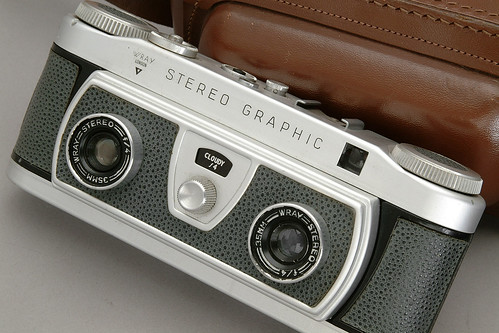Difference between revisions of "Wray"
(Heading added) |
(A few lens names) |
||
| Line 1: | Line 1: | ||
{{British companies}} | {{British companies}} | ||
| − | '''Wray''' was a British optical company, | + | '''Wray''' was a British optical company formed in 1850 in London,<ref>[http://www.earlyphotography.co.uk/site/companies5.html#W Company Notes] at [http://www.earlyphotography.co.uk/index.html Early Photography].</ref> and best known for lenses used in other makers' cameras. Wray made a couple of cameras after World War II, most notably the 35mm SLR [[Wrayflex]], and sold the [[Graflex Stereo Graphic]] camera under its own name. |
| + | ==Lenses== | ||
| + | * Lustrar: anastigmat composed of four elements, arranged as positive-negative-negative-positive. ''Early Photography'' lists a 135 mm f/4.8 example;<ref>[http://www.earlyphotography.co.uk/site/entry_L58.html#L114 f/4.8 Lustrar] at ''Early Photography''; no picture.</ref> Greenleaf lists it as an f/4.5<ref name=Greenleaf>Greenleaf, Allen R. (1950) ''Photographic Optics'', Macmillan, New York, pp201-8.</ref> | ||
| + | * Platystigmat (seen on some of [[J.T. Chapman]]'s 'British' cameras) | ||
| + | * Rapid Rectilinears including the Detective (seen on some of Chapman's cameras)<ref>[http://www.earlyphotography.co.uk/site/entry_L26.html Rapid Rectilinear lenses] at ''Early Photography''.</ref> | ||
| + | * Supar: a simple triplet.<ref name=Greenleaf/> | ||
| + | * Unilite: similar to the Lustrar, but with cemented negative elements.<ref name=Greenleaf/> | ||
| + | |||
| + | * CRT lens: an f/1 lens for photographing oscilloscope traces etc.<ref>[http://www.earlyphotography.co.uk/site/entry_L156.html#L148 2-inch f/1 CRT lens] at ''Early Photography'': diagram, but no photograph.</ref> | ||
| Line 15: | Line 23: | ||
| + | ==Notes== | ||
| + | <references/> | ||
Revision as of 20:15, 9 October 2014
| British companies | ||
| Adams & Co. | Agilux | Aldis | APeM | Aptus | Artima | Barnet Ensign | Beard | Beck | Benetfink | Billcliff | Boots | British Ferrotype | Butcher | Chapman | Cooke | Corfield | Coronet | Dallmeyer | Dekko | De Vere | Dixons | Dollond | Elliott | Gandolfi | Gnome | Griffiths | G. Hare | Houghtons | Houghton-Butcher | Hunter | Ilford | Jackson | Johnson | Kentmere | Kershaw-Soho | Kodak Ltd. | Lancaster | Lejeune and Perken | Lizars | London & Paris Optic & Clock Company | Marion | Marlow | Meagher | MPP | Neville | Newman & Guardia | Pearson and Denham | Perken, Son and Company | Perken, Son & Rayment | Photopia | Purma | Reid & Sigrist | Reynolds and Branson | Ross | Ross Ensign | Sanderson | Sands & Hunter | Shackman | Shew | Soho | Standard Cameras Ltd | Taylor-Hobson | Thornton-Pickard | Underwood | United | Watkins | Watson | Wynne's Infallible | Wray |
Wray was a British optical company formed in 1850 in London,[1] and best known for lenses used in other makers' cameras. Wray made a couple of cameras after World War II, most notably the 35mm SLR Wrayflex, and sold the Graflex Stereo Graphic camera under its own name.
Lenses
- Lustrar: anastigmat composed of four elements, arranged as positive-negative-negative-positive. Early Photography lists a 135 mm f/4.8 example;[2] Greenleaf lists it as an f/4.5[3]
- Platystigmat (seen on some of J.T. Chapman's 'British' cameras)
- Rapid Rectilinears including the Detective (seen on some of Chapman's cameras)[4]
- Supar: a simple triplet.[3]
- Unilite: similar to the Lustrar, but with cemented negative elements.[3]
- CRT lens: an f/1 lens for photographing oscilloscope traces etc.[5]

|
| Wray Stereo Graphic c.1959 image by Geoff Harrisson (Image rights) |
Notes
- ↑ Company Notes at Early Photography.
- ↑ f/4.8 Lustrar at Early Photography; no picture.
- ↑ 3.0 3.1 3.2 Greenleaf, Allen R. (1950) Photographic Optics, Macmillan, New York, pp201-8.
- ↑ Rapid Rectilinear lenses at Early Photography.
- ↑ 2-inch f/1 CRT lens at Early Photography: diagram, but no photograph.
Links
- Wray Stereo instruction manual at www.orphancameras.com